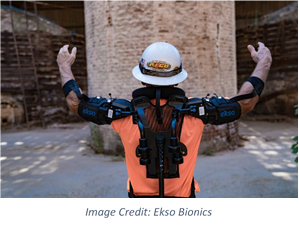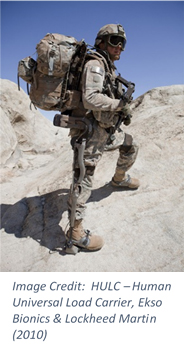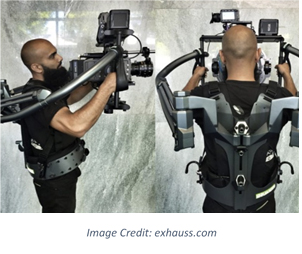There is a thought behind every action and a desire always plays its role behind that thought. Overlooking the basic needs and craving for power has always been an instinct of human being. And that thirst of power invents the first powered exoskeleton in 1917 before the “Superman” comes into picture in 1938.
The term exoskeleton originates from the external rigid skin of invertebrate animals like crabs, bugs, tortoise etc. that permits them to retain the shape without inner skeleton. Now in engineering point of view exoskeleton is a wearable robot which helps to augment, amplify or to reinforce the musculoskeletal arrangement of a human body which offers support, stability and movement.
The exoskeletons are categorized in colossal ways like-
In terms of power supply-
Active, which preform some activities with the help of actuator.
Passive, which does not required any type of external agents for movement but uses shape memory material, dampers or springs which can store energy and released at ease.
Depending on the body part-
Upper extremity exoskeleton- Upper limbs like arms, shoulder and torso.

Lower extremity exoskeleton- Lower limbs like hips, legs and lower tarsal bones.
Full body Exoskeleton- Most versatile and powerful exoskeleton for rehabilitation.
Based on technology of actuation or power supply-
Electrical- These are operated by electrical motors actuator or servo which multiplies human effort
Hydraulic- Operated by Fuel cells or IC engines, superior than electrical ones
Fully mechanical- These variants are mainly passive powered by springs or mechanical linkage. Muscles activity can reduced by 35% results in less fatigue of the worker.
Others- These are also based on passive powered like shape memory alloy or fuel cell actuator.
Also there are some classifications in terms of mobility like fixed, supported or mobile;
User machine interface that is controlled by joysticks or any control panel;
According to building material like Soft or flexible made of fabrics and other soft material and rigid materials like carbon fiber;
Based on source of production- home built (DIY), research labs (academia), commercial companies (industry), and governments.
Exoskeletons has a versatile field of applications like health care industry to support limb amputees, paraplegic patients or in case of physically disable persons; defense industry to amplify their power; manufacturing and construction industry to decrease worker’s muscle activity which will reduce their fatigue.
If we take only medical requirements, has a tremendous need of this in India. Primarily for Non-birth amputations caused by various injuries and others like cardiovascular, disease, traumatic accidents, spinal cord injury, nerve injury and congenital. Around 10 million amputees are present Worldwide of total approximate population of 6.7 billion. In India alone 0.5 million of amputees are there and that figure is increasing by 23500 per year. Though there are some prosthetic manufacturers but very few companies manufacture exoskeleton for medical purposes in India. And a in a developing country it is next to impossible to import an exosuit, costing around 60 lakh.

“Hardiman” was the first powered exoskeleton developed by General Electric in cooperation with US armed force in 1960s. This was the first military purpose exoskeleton which can amplify strength of wearer by 25 times. Also different countries like China, Canada, South Korea, Russia, Great Britain and Australia are tested their military exoskeleton. From 2019 onward, Indian Defense Research and Development Organization (DRDO)’s Defense Bioengineering and Electro-medical Laboratory (DEBEL) in collaboration with some higher education Institutions, is trying to develop futuristic defense equipment’s.

As of now the collaborative robot industrial sector is the fastest growing market for exoskeleton. They can reduce ergonomics issues, musculoskeletal injuries and fatigue which are very common disturbing factors to the workers and as well as to the companies in construction sites, factories, dry-docks, warehouses which is very common and disturbing to the worker as well as to the company. Industrial use of exoskeleton in India is in bottom level yet, but it is a low hanging fruit for young entrepreneur.
The smallest subfield for exoskeleton is commercial sector. Main prospective of commercial exoskeleton can be found in motorized transportation and sports and hiking application. This type of transportation requires minimum infrastructure with maximum flexibility and educational application is mostly hypothetical.
As per various research reports worldwide exoskeleton revenue will reach $5.8 billion by 2028, driven by the plan and appropriation of only passive exoskeletons that help to amplify capacities of human power. Though geologically, the exoskeleton market scope changes significantly across various regions. The purpose behind this lies in the pace of mechanical advancements in various pieces of the world.

For the most of us, technology makes things simpler; anyway for an individual with disability, it makes things conceivable. India is where only individuals who are incapacitated, gets legitimate treatment from time to time. Because of the significant expense of prosthesis, only the higher earnings families can manage the cost of them. But in near future in India the higher growth rate will be experienced, owing to the factors such as growing aged population and increasing prevalence of stroke & spinal cord injuries, presence of large pool of patients, increasing disposable income, and availability of government funding.
Visited 2199 times, 1 Visit today



